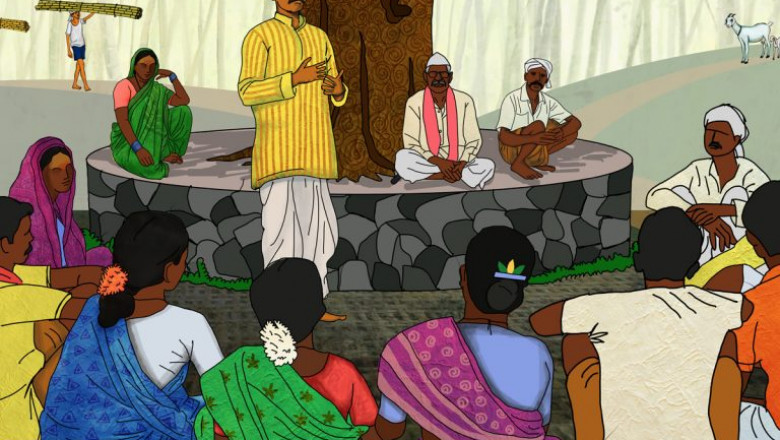views

The canons contained in Part 9 of the Constitution of India concerning the Panchayats were not pertinent to the tribal regions included in Schedule 5 of the Constitution.
Hayati Raj Acts.PESA full form is Provisions of the Panchayats (Extension to the Scheduled Areas) Act.
The canons contained in Part 9 of the Constitution of India concerning the Panchayats were not pertinent to the tribal regions included in Schedule 5 of the Constitution.
But, the Parliament can extend the said provision to the specified tribal areas bearing in mind certain exceptions.
Hence, to extend the benefits of the Panchayati Raj System to such Adivasi regions, the legislators legislated “Provisions of the Panchayats (Extension to the Scheduled Areas) Act”, 1996, commonly referred to as “PESA Act” or “the Extension Act”.
Presently, the Fifth Schedule of the Constitution covers the following 10 Adivasi regions, namely:
- Andhra Pradesh
- Telangana
- Chhattisgarh
- Gujarat
- Himachal Pradesh
- Jharkhand
- Madhya Pradesh
- Maharashtra
- Odisha
- Rajasthan.
Respective ten scheduled areas have legislated the required compliance enactment by modifying the respective Panc
Introduction of PESA Act
The government of India legislated The Provisions of the Panchayats (Extension to Scheduled Areas) Act, or PESA act 1996.
The act intended to ensure autonomy by adapting the customary Gram Sabhas administration system for the people residing in such Scheduled Areas of India.
Initially, under the 73rd Constitutional Amendment, which laid down the foundation for the Panchayati Raj System, scheduled areas did not find a place.
Article 243 (M) of the Constitution made sure to restrict the amendment applicable to the scheduled areas.
After establishing the Bhuria Committee in 1995, the PESA ACT 1996 came into existence and reassured the self-governance of Adivasis.
The PESA Act aimed to operate the Panchayats at the required levels. The Act would aid Gram Sabha to regulate primary tribal concerns like traditional resources, forest supplies, minerals, water resources etc. The PESA act got perceived as a positive outcome for the upliftment of the scheduled area.
For a considerable period, these socially excluded people suffered immensely at the hands of archaic colonial statues even after the independence of India. They were rendered vulnerable at the loss of forest, water and land resources overtaken under the veil of development.
Unrestricted acquisition of land and other resources for the pragmatic generative projects leads to wide displacement of tribal people residing in Scheduled Areas.
Hence, The PESA Act came as a remedy to heal these vulnerabilities and established a paradigm shift.
Features of PESA ACT 1996
Restoration of self-governance:
The prime aim of the said act was to restore the right of autonomy lost to the exterior legislatures.
Gram Sabha as a Focal Point:
The governmental body in Gram Sabha was established and made the focal point of democracy and liberty.
Safeguarding Culture and Traditions:
With newly gained power, the Adivasis could now engage their culture and traditions in the decision making and hence, preserve them.
Consultations for Acquisition:
The acts utmost important feature was to mandate the prior discussion with the people residing in the scheduled areas before acquiring their land.
Other than this, the Act empowered the tribal people with the ownership of “minor land produce“, local dispute resolution and managing their rural and traditional markets.
Concerns on PESA Act
Fragmentary Implementation
Though the PESA Act returns the autonomy to the scheduled areas, the regional authorities get obliged to enact state laws. Hence, leading to the fragmentary implementation of self-governance that further worsens the conditions of Adivasis.
Political and Legal Challenges
Its observed that the implementation of the PESA Act faces legal challenges and political resistance. It makes the working of the Act unclear.
Pseudo Approvals
Social audits shattered the colourful image of the implementation of the PESA Act. Pragmatically, the growth projects are granted pseudo approvals, just on the papers, without real discussions and permissions with the members of Gram Sabha in these scheduled areas.
Importance of Scheduled Areas
Culture is the fundamental identity of a man and something that distinguishes one community from other. Thus, culture is integral to a man and must get preserved at all costs. India is the land of various cultures, and the preservation of all is a must.
With one such aim, the Constitution framers set few areas under the fifth schedule and termed them Scheduled Areas.
As per Article 244(1), “Scheduled Areas as such areas as the President may by order declare to be Scheduled Areas after consultation with the Governor of that State“.
Significance Of Scheduled Areas
The importance of scheduled areas is as follows:
- Preserving the culture.
- Retaining the identity.
- Restoring the lost traditions.
- Ensuring their rights.
- The promise of their betterment.
<a href="https://getlegalindia.com/pesa-act/">Know More</a>












Comments
0 comment